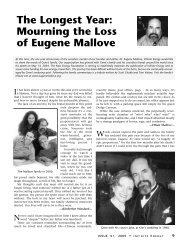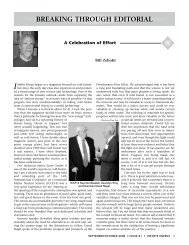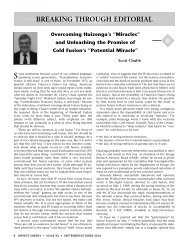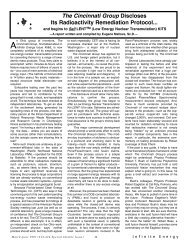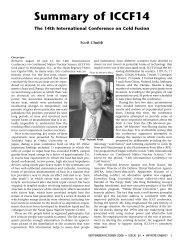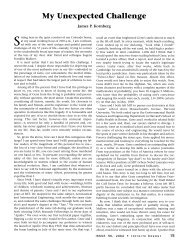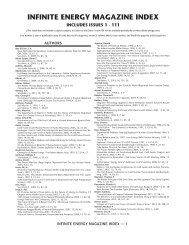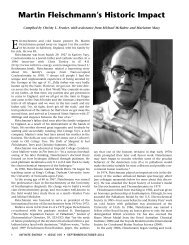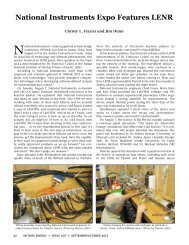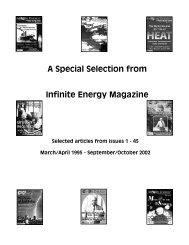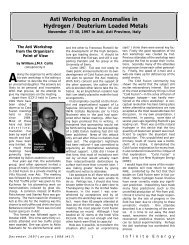MIT and Cold Fusion: A Special Report - Infinite Energy Magazine
MIT and Cold Fusion: A Special Report - Infinite Energy Magazine
MIT and Cold Fusion: A Special Report - Infinite Energy Magazine
Create successful ePaper yourself
Turn your PDF publications into a flip-book with our unique Google optimized e-Paper software.
Other Issues<br />
The preceding is the basic story of what went on at <strong>MIT</strong> in<br />
1989-1992. Much of this could have been avoided if President<br />
Vest had had an open-door policy toward appropriate scientific<br />
dissent. On April 12, 1991, I had sent a letter to President Vest<br />
(see Exhibit I), at a time when I was feeling optimistic about<br />
what could be accomplished. I had hoped that the new <strong>MIT</strong><br />
President, who had replaced the outgoing Dr. Paul E. Gray,<br />
would take action on its important message. I recommended<br />
that a study group be formed to re-examine what had been<br />
learned about cold fusion since 1989. Should I have been surprised<br />
at not receiving a response? Not when President Vest<br />
had chosen Chemistry Department head Mark Wrighton, to be<br />
Provost. Examine Wrighton’s brusk <strong>and</strong> totally inappropriate<br />
response to Dr. Noninski (Exhibit H). Wrighton’s “let me make<br />
this perfectly clear I have no comment” letter is not a response<br />
that a scientist with integrity would have written.<br />
After the events of 1991-1992, there followed many hard years<br />
of struggle, working with other engineers <strong>and</strong> scientists in cold<br />
fusion research, <strong>and</strong> trying to correct false impressions about<br />
cold fusion investigations that were being made by journalists<br />
<strong>and</strong> government officials. The launching of <strong>Infinite</strong> <strong>Energy</strong> magazine<br />
in 1995 (<strong>and</strong> its short-lived precursor, <strong>Cold</strong> <strong>Fusion</strong> magazine,<br />
1994) was, in part, a response to the egregious distortions about<br />
cold fusion that were initiated by members of the <strong>MIT</strong> PFC.<br />
Fire from Ice was well received by many reviewers, but its message<br />
was largely drowned out by an onslaught of scurrilous anticold<br />
fusion books, the first one by Frank Close, Too Hot to H<strong>and</strong>le<br />
(1991). Dr. Richard Petrasso of the <strong>MIT</strong> PFC had aided Close’s<br />
work. He was in complete agreement with Close’s opinions; witness<br />
his comment published on the front page of the Sunday New<br />
York Times, March 17, 1991, which was essentially a laudatory<br />
review of the book by Close. Recall Dr. Petrasso’s words: “I was<br />
convinced for a while it was absolute fraud. Now I’ve softened.<br />
They [Pons <strong>and</strong> Fleischmann] probably believed in what they were<br />
doing. But how they represented it was a dear violation of how science<br />
should be done.” A case of the pot calling the kettle black, I’d<br />
say, in light of the technical publication to which Petrasso (<strong>and</strong> fifto<br />
h<strong>and</strong>le the data <strong>and</strong> write a subsequent “Technical Appendix”<br />
that made further excuses for data mish<strong>and</strong>ling. As Dr. Swartz<br />
has shown, the data was, indeed, altered yet again during the<br />
“investigation”! For now, I hope that Dr. Swartz’s analysis, <strong>and</strong><br />
my own assessments <strong>and</strong> exchanges with President Vest, will be<br />
examined carefully by all who still have an open mind about the<br />
historical development of the cold fusion controversy.<br />
My conclusions about the inappropriate data manipulation<br />
at the <strong>MIT</strong> PFC are my own <strong>and</strong> my opinions about the implications<br />
of this data mish<strong>and</strong>ling are to be considered distinct from Dr.<br />
Swartz’s. My assessments of the <strong>MIT</strong> calorimetry <strong>and</strong> data h<strong>and</strong>ling<br />
appear in my Letter of Resignation (Exhibit L), my formal<br />
request for an investigation of scientific misconduct (Exhibit R),<br />
<strong>and</strong> other exchanges with President Vest that form the exhibits<br />
to this report. But let me quote Dr. Swartz’s summary conclusions<br />
from his fourteen-page technical paper:<br />
From: Dr. Mitchell R. Swartz’s, “Re-Examination of a Key <strong>Cold</strong><br />
<strong>Fusion</strong> Experiment: ‘Phase-II’ Calorimetry by the <strong>MIT</strong> Plasma<br />
<strong>Fusion</strong> Center,” <strong>Fusion</strong> Facts, August 1992, pp. 27-40.<br />
The light water curve was published by the PFC essentially intact<br />
after the first baseline shift, whereas the heavy water curve was shifted<br />
a second time. The cells were matched, 12 <strong>and</strong> solvent loss would<br />
be expected to be greater for H 2 O.<br />
The Phase-II methodology is flawed because it masks a constant<br />
[steady-state] excess heat. Furthermore this paradigm fails to use<br />
either the true baseline drift, <strong>and</strong> may avoid the first 15% of the D 2 O<br />
curve in Types 3, 3 B , 4, <strong>and</strong> 5 curves.<br />
What constitutes “data reduction” is sometimes but not always<br />
open to scientific debate. The application of a low pass filter to an<br />
electrical signal or the cutting in half of a hologram properly constitute<br />
“data reduction,” but the asymmetric shifting of one curve<br />
of a paired set is probably not. The removal of the entire steady<br />
state signal is also not classical “data reduction.”<br />
In the May 1992 Appendix, the PFC retroactively claims its<br />
“systematic errors now total 100 to 400 milliwatts, implying an<br />
insensitivity of >30 kilojoules.<br />
Much current skepticism of the cold fusion phenomenon was<br />
created by the PFC paper’s reporting “failure-to-reproduce.” 12 as<br />
opposed to its later claimed “to insensitive-to-confirm” experiments<br />
17 ]. Because it may be the single most widely quoted work<br />
used by critics of cold fusion to dismiss the phenomenon, the<br />
paper should have clarified all “data” points <strong>and</strong> the methodology<br />
used. Apparent curve proliferation, volatile points, asymmetric<br />
curve shifts, combined with an impaired methodology have needlessly<br />
degraded the sensitivity, <strong>and</strong> believability of the Phase II<br />
calorimetry experiment.<br />
12. D. Albagli, R. Ballinger, V. Cammarata, X. Chen, R.M. Crooks, C.<br />
Fiore, M.P.J. Gaudreau, I. Hwang, C.K. Li, P. Linsay, S.C. Luckhardt,<br />
R.R. Parker, R.D. Petrasso, M.O. Schloh, K.W. Wensel, M.S. Wrighton,<br />
“Measurement <strong>and</strong> Analysis of Neutron <strong>and</strong> Gamma-Ray Emission<br />
Rates, other <strong>Fusion</strong> Products, <strong>and</strong> the Power in Electrochemical Cells<br />
Having Pd Cathodes,” Journal of <strong>Fusion</strong> <strong>Energy</strong>, 9, 133, 1990.<br />
17. S.C. Luckhardt, “Technical Appendix to D. Albagli et al., J. <strong>Fusion</strong><br />
<strong>Energy</strong>, 1990, Calorimetry Error Analysis,” <strong>MIT</strong> <strong>Report</strong> PFC/RR-92-<br />
7, (May 1992).<br />
Present <strong>MIT</strong> students as well as alumni should investigate this<br />
most unfortunate episode for themselves, <strong>and</strong> take action—for<br />
the well-being of <strong>MIT</strong>. There is no doubt in my mind that the<br />
<strong>MIT</strong> PFC calorimetry was mish<strong>and</strong>led <strong>and</strong> fraudulently misrepresented.<br />
Dr. Swartz’s paper, using proper analysis that<br />
could have been performed by the <strong>MIT</strong> PFC, determined that<br />
“the average power by this method is 62 milliwatts (±34 milliwatts).”<br />
As Dr. Swartz states, this is “qualitatively similar to the<br />
value expected for a ‘successful’ experiment.” Furthermore, Dr.<br />
Swartz credits in his references <strong>and</strong> conclusions my August<br />
1991 complaint to President Vest (see Exhibit R) that a “20% discrepancy<br />
in heater power, used to heat the same volume of fluid,<br />
has been suggested as corroborating evidence that the heavy<br />
water cell produced excess heat.”<br />
At the very least it was scientifically <strong>and</strong> morally required<br />
that the <strong>MIT</strong> PFC group repeat its experiments, rather than having<br />
them cited year after year against cold fusion, when they<br />
should have been retracted or corrected, per the suggestion of<br />
physicist Dr. Charles McCutchen—see Exhibit Z-11. To cover up<br />
a sorry episode may have been comfortable for the <strong>MIT</strong> administration<br />
in an era in which cold fusion had not yet achieved general<br />
acceptance (thanks in no small way to some on the <strong>MIT</strong><br />
staff), but that era will pass. An age of enlightenment is coming<br />
that will make the tokamak hot fusion program at <strong>MIT</strong> a footnote<br />
to history. The era of safe, clean, <strong>and</strong> abundant energy from<br />
water—non-chemical energy from hydrogen—will drown the<br />
deceivers from <strong>MIT</strong> to Princeton. (If anyone has any doubt about<br />
this emerging commercial reality, they should consult one of the<br />
energy-from-water corporations that was influenced by the<br />
announcement of Fleischmann <strong>and</strong> Pons—see BlackLight Power<br />
Corp. [www.blacklightpower.com]. No doubt many bright <strong>MIT</strong><br />
graduates will be employed there.) No one can say that we did<br />
not warn <strong>MIT</strong> officials of the consequences if this important matter<br />
was allowed to be mish<strong>and</strong>led at <strong>MIT</strong> the way it was <strong>and</strong><br />
continues to be.<br />
16 <strong>Infinite</strong> <strong>Energy</strong> • ISSUE 24, 1999 • <strong>MIT</strong> <strong>Special</strong> <strong>Report</strong>



